- 8 reads

Our GREENandSAVE Team is pleased to share information like this about sustainability solution providers. If you would like to submit information on your company, please contact us.
TIME TO ACT:
Save 20% or more on HVAC. It’s important now more than ever for a sustainable future!
Optimizing PTAC units with a “smart” device is a fast, easy, and cost-effective way to achieve Commercial HVAC Energy Savings. A Packaged Terminal Air Conditioner is a type of self-contained heating and air conditioning system commonly found in: Hotels, Motels, Senior Housing Facilities, Hospitals, Condominiums, Apartment Buildings, and Add-on Rooms & Sunrooms.
Business owners and homeowners face increasing challenges with energy costs to save energy and money in New York. PTAC Energy Saver offers an Adaptive Climate Controller (ACC). It is a proven HVAC energy saving device that quickly installs on PTAC units. There are many companies that claim to produce energy savings, but the ACC device is multi-panted and proven over many years. Plus, it has extensive validation tests by organizations such as:
- ConEdison, Manhattan Plaza New York City
- Environmental Test Laboratory, Ohio
- EME Consulting Engineers (Third Party), Sponsored by NYSERDA, New York
- State University of New York, Oneonta, NY
- Tim Garrison (Third Party Testing)
- McQuay Cooling Tests
- Purdue University Tests (Phoenix)
- ConEdison Tests by ERS
Typically, when an HVAC system turns off, shortly after, the blower fan motor turns off. The ACC reprograms the blower fan not to shut off but to throttle back the rpm airflow to an exceptionally low speed, quiescent level airflow or “idle speed”. This allows for a gentle but continuous air movement into the building that helps keep equilibrium of climate conditions in the occupied space and saved energy.
PTAC Energy Saver can help you navigate the complexity of HVAC energy saving choices: CONTACT PTAC Energy Saver
Here is an example of some Commercial HVAC Energy Saving info for New York:
Gil-Bar in the News: “Modernized HVAC Systems Have Key Role in New York City”
New energy-efficiency requirements mandated by NYC in Local Law 97, part of the Climate Modernization Act, amount to some of the most sweeping sustainability measures passed by any city globally. Commercial properties spanning more than 25,000 s/f will see their carbon emissions caps tighten starting in 2024 and must achieve a 40% reduction to their carbon footprints by 2030, based on a 2005 emission data baseline. By 2050, the city is targeting an 80% reduction for commercial buildings. In November, the city amended the law to include buildings with rent-regulated units, which were originally exempt. As it stands, Local Law 97 will affect 50,000 buildings in NYC.
The progress of NYC’s landlords in meeting the 40% reductions required by 2030 target is not uniform. Closer to reaching the new 2024 caps are larger, institutional level landlords–they can more easily access the capital needed to begin retrofitting older buildings with advanced, energy-efficient systems and incorporate energy-efficient infrastructure into their new projects. But the majority of Manhattan’s commercial landlords do not operate at an institutional scale and the majority of its buildings are at least 30 years old. As emissions caps tighten, significantly more capital improvements will be needed for the vast array of Manhattan commercial buildings. The Urban Green Council has forecast that by 2030, the energy retrofit market opportunity in NYC will range from $16.6 and $24.3 billion. (In comparison, about $235 million was spent on energy-saving building improvements in 2018.) Right now across the city, owners of commercial real estate are consulting with HVAC, engineering and efficiency experts to understand and roll out the types of retrofitting they will need.
To really make a dent in their carbon footprints, landlords will need to assess and upgrade their HVAC systems. Engineering research has shown that installing energy-efficient systems can have a significant impact on the carbon-emissions performance of older buildings. The heating and cooling of a building is one of the biggest contributors to its carbon footprint; traditional HVAC systems can account for about half of a building’s energy use.
A number of new HVAC systems and technologies are available to building owners to help reduce energy consumption. These efficiency systems utilize less power load thanks to advances in materials, engineering technology and installation procedures. For example, dedicated outdoor air systems are a type of HVAC that can dehumidify air, improve indoor air quality and reduce energy load by venting outdoor air separately. Passive and active chilled beam systems for ceilings are another HVAC option for reducing energy output and thus, building emissions. Sophisticated HVAC options are complex enough to create microenvironments within buildings that can be independently controlled by occupants. Besides being energy efficient, a variable flow HVAC system runs more quietly and offers fine-tuned environmental control with multiple heating and cooling zones.
Working closely with an HVAC specialist is essential to the equation of balancing new energy-efficiency requirements within a commercial building’s envelope. Through the scope of projects, HVAC specialists coordinate with manufacturers on a continuing basis and can leverage these relationships to the benefit of landlords making decisions on retrofits or new installations. Because manufacturers know their products inside and out, they are valuable partners working in concert with HVAC specialists to decide which systems will produce optimal efficiency results for their properties. Landlords should regard the guidance gained from HVAC specialists as essential to solving the puzzle of Local Law 97 compliance.
HVAC systems are far from blanket solutions. Every commercial building in the city has unique characteristics of age, building material and existing infrastructure, and bringing in the right expertise is crucial to ensuring a building is optimized for a reduced footprint. These proactive measures will ultimately help owners avoid penalties and even realize facility management savings in the long run.

